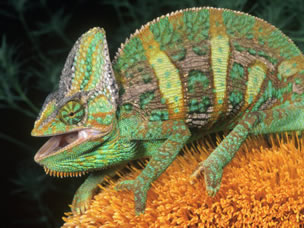Veiled Chameleon Care Sheet
 Scientific Name: Chamaeleo calyptratus Scientific Name: Chamaeleo calyptratus
Lifespan: Four – Seven Years (Females have shorter lifespans)
Size: Veiled chameleons can get up to 18 inches long.
Handling: Grabbing a chameleon will cause it to become very stressed which leads to a considerably shorter lifespan. If you want to handle your chameleon, then let it crawl onto your finger of its own free will.
Size of Enclosure for Veiled Chameleons
It's best to use screened in enclosures for Veiled chameleons rather than glass aquariums. The reason is because a screened enclosure offers much better circulation than glass. You can use glass so long as you install fans to circulate the air. However, it's easier to just invest in a Reptarium. Having optimum ventilation will help to prevent serious respiratory infections.
Even though smaller chameleons should be kept in smaller areas, you should still go ahead and invest in an adult sized cage. You can simply decorate a small portion to accommodate the young chameleon, adding to it as the lizard grows in size. Here is the space requirements of a Veiled chameleon based on its age.
1-4 Months: 16 x 16 x 30 inches.
Older than 4 Months: 18 x 18 x 36 inches (minimum). 24 x 24 x 48 recommended.
Setup of the Enclosure
Veiled chameleons love to stay off the ground, living in trees and climbing across branches in search of food. Since it's best to set up a chameleon's cage as closely as possible to nature, you should include plants, artificial vines, foliage, and strategic branches. This gives your chameleon the appearance that it's in the wild. Trust me, it will put every branch and vine to use.
I recommend that you use fake branches and artificial vines since real ones can transmit diseases. If you opt to use real branches and plants then you must be absolutely sure to disinfect them before exposing your chameleon. You can actually use an oven to disinfect dead branches by baking them at 350 degrees. For plants, you should replant them in fresh soil.
Foliage should be spread across the enclosure so that the chameleon feels at home. He will want to be able to hide if the mood strikes.
Proper Heating and Lighting Techniques for a Veiled Chameleon
Veiled chameleons love to bask in the warmth of the sun. Since there is no sun in your home, you will have to simulate sunlight with lamps. There are two different types of lamps you will need.
UVB
The most important light is the UVB since it is designed to help chameleons form important vitamin D. It helps to ensure that the chameleon has strong bones. Without a proper light, a Veiled chameleon has a high chance of contracting Metabolic Bone Disease (MBD). Check out "Chameleon Care Guide" for an in-depth information on how to identify, treat and prevent illnesses and poor health.
I recommend a tube version of this light as opposed to the coil variety. Tube versions last longer and are much more effective.
Note that UVB bulbs must be replaced every six months. They lose effectiveness after that.
Basking Lamp
The basking lamp is the one that is used to regulating heat. Veiled chameleons love to rest under this light. This area will be the hottest in the cage. Keep in mind that a chameleon will try and get as close to the heat as possible so make sure it cannot possibly get within 12 inches, otherwise it will get burned. If you believe that the chameleon will know better than to get close enough to burn itself, then you're mistaken. Chameleons don't feel when they are being burned.
This bulb will typically need to be anywhere from 75 watts to 100 watts to ensure proper heating.
Temperature Requirements
First of all, go out and buy a digital thermometer, then install it inside of the tank. You should never try and guess the temperature because a few degrees can make a world of difference. Once you have the thermometer installed, here are the optimum temperatures for Veiled chameleons.
Daytime
Baby Veiled Chameleon
Ambient temperature: 72-75 Degrees
Basking temperature: 85-88 Degrees
Adult Veiled Chameleon
Ambient temperature: 75-80 Degrees
Basking temperature: 90-95 Degrees
Nighttime
At night, you should not need to use any lights. The goal is to drop the temperature around 10 degrees. If it gets too cold, then you might need to purchase a ceramic heat emitter.
Feeding, Watering, and Humidifying your Veiled Chameleon
Veiled chameleons enjoy a wide variety of insects like crickets, hornworms, silkworms, roaches, and even those dried flies you can find in the fish food section. Some of them will even eat live plants from time to time so make sure you leave out any toxic plants if opting to include live plants within the enclosure.
Install a hygrometer inside of the habitat. You must never let the humidity drop below 50%. Increase it as needed my manually misting the cage.
Veiled chameleons prefer to lick water droplets off leaves rather than drink from a standing water source. Therefore, you should install some kind of drip system that will drop water onto leaves.

|